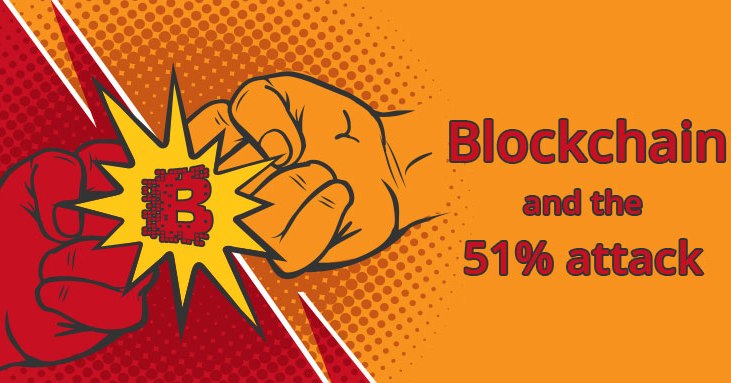Attack 51%: is there a probability of network capture and what kind of crypto currency is it to be afraid of?

Cryptocurrencies have the reputation of reliable and super-secure payment systems, but are they really impregnable? It turns out that everything is not so simple and you can even hack such an invincible coin as Bitcoin. Representatives of the community are afraid of “51% attacks”, which can not only bring down the course of cryptocurrency, but also simply destroy it. What kind of animal it is and whether the 51% attack really will lead to a cryptocurrency apocalypse - we’ll sort everything out in this article.
Terrifying 51% attack - what is it?
Cryptographically protected money and blockchain technologies are real know-how, so we are already used to the fact that not everything is the same with them as in the traditional world. Since the entire cryptocurrency industry is built on the digital plane, the danger of the offline world does not threaten such money either. Most of the users who have tried to delve into the crypto at least with the edge of their ear are 100% sure that cryptocurrencies are omnipotent and cannot be hacked in any way. How else, if complex mathematical encryption is guarding the order? But in fact, you can hack anything, moreover, all possible cyberattacks of cryptosystems have long been known and described, one of the most dangerous is the "51% attack."

It's not a secret to anyone that miners play a big role in bitcoin-like crypto-currencies. They have the function of generating new blocks, they enter and confirm new transactions, and in addition, they are the core of the security for the entire system. How not to twist, and the more in the network of miners, the stronger it is and more reliable. Well, due to the huge number of miners and they operate separately, the system is decentralized.
But with the emergence and development of mining pools, which combine the power of different computers into a single force to make the process of mining coins more efficient, the balance of power in the mining community has changed somewhat. Some of them began to actively increase power, while small pools began to go out of the way. What do you say bad here? To answer this question, let's go back to the formidable 51% attack.
Imagine a company in which a separate character is the controlling shareholder. In fact, this person will solve all the main issues of this company. In the network of crypto currency, depending on the mining, everything happens almost the same way - if someone takes possession of 51% of its capacity, then it opens up unlimited possibilities.
How can a domination attack occur?
If any mining pool will rapidly increase its capacity, then it can quite reach 51% of the total network hash. Theoretically, an individual can seize such capacities, but such a farm will cost a very large amount of money to this large farmer. If we talk about the attack on bitcoin, then the cost of 51% of equipment will reach simply cosmic sums.

We note at once that hypothetically, the main crypto currency can also attack, but in this case the cyber-attacker will not receive any commercial profit. But with young crypto-currencies, which have not so many miners, such a focus can be quite successful.
Any reader, for sure, the question arose, can the producers of asiks capture the network? After all, who else owns the largest reserve of mining equipment, if not its creators. Of course, the company Bitmain can organize an attack 51% will be the cheapest. But, ironically, just asik traders such an attack will not be at hand. Agree that it is much more profitable for many years to get a super profit from selling their asss than to break the bitcoin rate and, in the end, not even recoup the cost of used equipment.
Such an attack is also not beneficial to the large mining pools that exist at the expense of the commission from the miners, so there is an agreement between them not to exceed the hash pool above 40% of the total network capacity.
Benefit from 51 attack
Why would anyone attack bitcoin and altcoins? The owner of solid power can pursue the most diverse goals of such cryptocurrency hacking. First of all, a similar scheme is used to destroy competitors from among the newly minted coins. A compromised crypt may simply be left without anyone who wants to buy it, and this will lead to its complete depreciation and death.

The second, no less significant reason for encroachment on the crypto currency may consist in a banal commercial gain. Due to the fact that the miner with the greatest capacity can do different manipulations with the block, he can quite profit from this financial gain. Such "egoistic mining" can lead to very undesirable consequences for the network:
- Miner can calmly to earn the crypto currency in the accelerated mode - hundreds of thousands of coins can be mined in a matter of minutes.
- With ease it will be possible cancel any transactions.
- It is likely double waste. Miner can send the same coins to other wallets as many times as necessary.
- 51% of capacity will do hard-hearted, under which the block of one crypto currency will branch out.
What could be the consequences?
Cryptocurrency compromised by an attack immediately ceases to be an interesting investment, moreover, at the time of the attack, the coin owners themselves will not even use it. Understanding that someone owns the network, users just have to wait for the resolution of this problem. Of course, all this will cause the coin to fall in value, and it is very likely that the fall will be catastrophic. And even if a miner or pool becomes the owner of the capacities for a short time and is purely accidental, all the same, even the possibility of such control of the network will alienate buyers from cryptocurrency.

If dominance in the network lasts a long time, one can even expect that the crypto currency will completely lose its audience, and since the value of any coin in demand for it, it will mean its complete disappearance. At bitcoin forums, this possibility is called one of the most probable ways of regulation by the state. For example, if such a power as China decides to confiscate all equipment for mining on its territory, it will easily become the owner of the largest network hash. But while the Chinese authorities do not come up with the idea to destroy bitcoin in this way, let's hope that the measures of the state will not be so drastic.
Cases of domination in the network and who needs to be afraid of such an attack?
For a long time, the "51% attack" was considered probable only in theory, but some cryptocurrencies had a chance to learn in practice what it is. Even bitcoin itself has gotten into a tricky situation more than once, but if in his case the community got by with a slight fright, then some altcoins were less fortunate.
- From time to time, one or the other pool becomes the largest congestion in the network Bitcoin... There have been cases when dominance exceeded 50%, but so far it has been used only for peaceful purposes and, according to the agreement between the pools, in the future, the "51% attack" of the main cryptocurrency will be able to avoid. But in 2014, the Ghash.io pool controlled 55% of the cue ball's power!
- If the progenitor of all cryptocurrencies managed to bypass the "51% attack" by the side, then his followers did not succeed so much, especially the fork called Bitcoin Gold. Not so long ago in the network of this crypto currency there appeared a miner with dominating capacities and this enriched the cybercriter on 17.5 $ million.
- Even less lucky was the crypto currency Verge, which was robbed twice this year thanks to the 51% attack. Just the other day, the cryptocurrency was once again attacked and the attackers managed to mine at a speed of 25 blocks per minute. After mining 35 million coins, which is $ 1.75 million at the current exchange rate, the attack stopped.

In general, any crypto-currencies that work on the algorithm "Proof Of Work" can be attacked. The cost of the attack, and hence the probability of its occurrence, for each coin will be different.
How to protect cryptocurrencies from 51% attack?
Even the very possibility that enough power is concentrated in someone's hands for a "51% attack" scares many coin holders and members of the community. But a solution has already been found, moreover, several ways of protecting against a dominance attack have been proposed. One of the options is called the transition of cryptocurrencies to Proof-of-Stake. This algorithm assumes that the generation of blocks will be conducted by coin holders. Who has more coins, he is online and stronger. According to the developers, large holders of coins will be interested in the development of the system, and not in attacking it.
The 51% attack is still a threat that hangs over many cryptocurrencies, and it can be used by cybercriminals in different scenarios. But while most of the community members who could carry out the attack, it is not profitable, so you should not worry too much about the accumulation of a large hash rate in one hand. As for the new generation cryptocurrencies, which have moved as far as possible from bitcoin, they do not even care about such attacks. New developments are much ahead of the resourcefulness of the mind of cybercriminals and in the future, with the improvement of crypto technologies, no attacks on digital money will be scary. Therefore, feel free to use cryptocurrencies and benefit from it, while thinking about attacks and vulnerabilities is best left to professionals.
May 30, 2018














